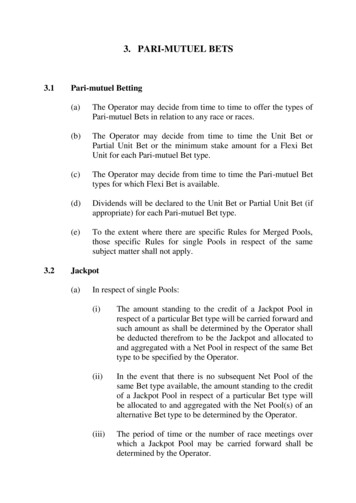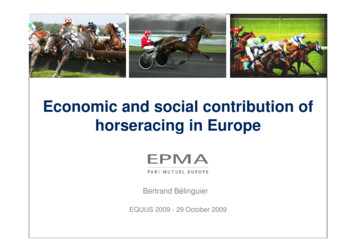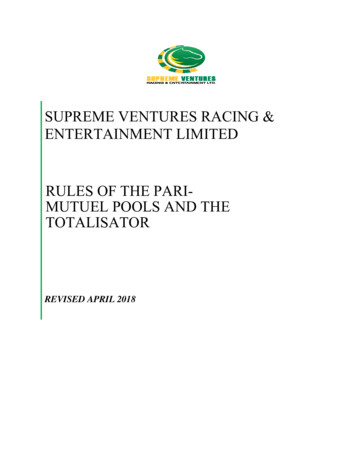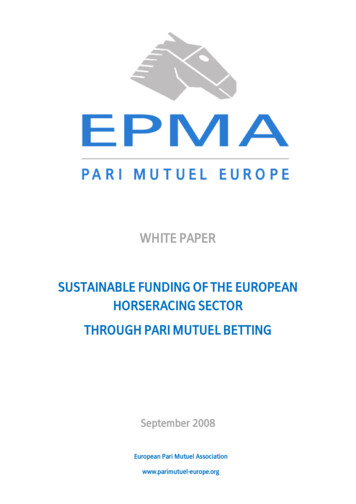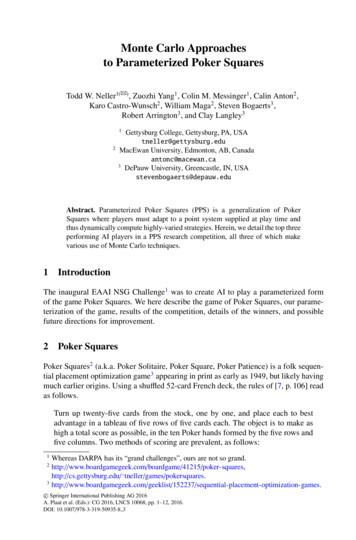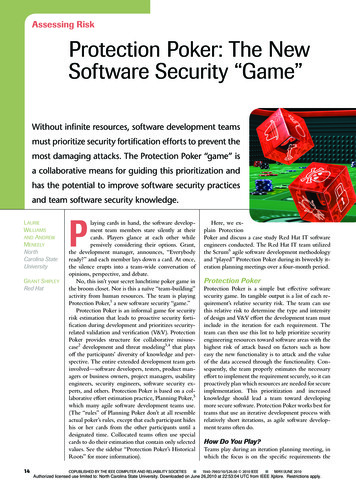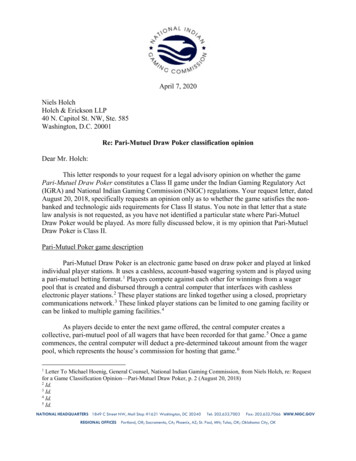
Transcription
April 7, 2020Niels HolchHolch & Erickson LLP40 N. Capitol St. NW, Ste. 585Washington, D.C. 20001Re: Pari-Mutuel Draw Poker classification opinionDear Mr. Holch:This letter responds to your request for a legal advisory opinion on whether the gamePari-Mutuel Draw Poker constitutes a Class II game under the Indian Gaming Regulatory Act(IGRA) and National Indian Gaming Commission (NIGC) regulations. Your request letter, datedAugust 20, 2018, specifically requests an opinion only as to whether the game satisfies the nonbanked and technologic aids requirements for Class II status. You note in that letter that a statelaw analysis is not requested, as you have not identified a particular state where Pari-MutuelDraw Poker would be played. As more fully discussed below, it is my opinion that Pari-MutuelDraw Poker is Class II.Pari-Mutuel Poker game descriptionPari-Mutuel Draw Poker is an electronic game based on draw poker and played at linkedindividual player stations. It uses a cashless, account-based wagering system and is played usinga pari-mutuel betting format. 1 Players compete against each other for winnings from a wagerpool that is created and disbursed through a central computer that interfaces with cashlesselectronic player stations. 2 These player stations are linked together using a closed, proprietarycommunications network. 3 These linked player stations can be limited to one gaming facility orcan be linked to multiple gaming facilities. 4As players decide to enter the next game offered, the central computer creates acollective, pari-mutuel pool of all wagers that have been recorded for that game. 5 Once a gamecommences, the central computer will deduct a pre-determined takeout amount from the wagerpool, which represents the house’s commission for hosting that game. 6Letter To Michael Hoenig, General Counsel, National Indian Gaming Commission, from Niels Holch, re: Requestfor a Game Classification Opinion—Pari-Mutuel Draw Poker, p. 2 (August 20, 2018)2Id.3Id.4Id.5Id.1NATIONAL HEADQUARTERS 1849 C Street NW, Mail Stop #1621 Washington, DC 20240REGIONAL OFFICESTel: 202.632.7003Fax: 202.632.7066 WWW.NIGC.GOVPortland, OR; Sacramento, CA; Phoenix, AZ; St. Paul, MN; Tulsa, OK; Oklahoma City, OK
Niels HolchRe: Pari-Mutuel Draw Poker classification opinionApril 7, 2020Page 2 of 6To accommodate a large number of players, the system generates a 52 card virtual deckfor each player. 7 From those individual decks, the system then randomly selects five playing cardsper player and displays them on the individual video monitor. 8 The player is provided with a fixedamount of time to hold or discard any or all of these five cards. 9 After the player has made his or herhold/discard decisions, the electronic selection device randomly selects new cards from theindividual decks to replace those that have been discarded. 10After the draw has occurred and any discarded cards have been replaced, the five cards inthe player's hand will be evaluated against the hands presented on other player stations enteredin the same game.11 The entire wager pool (after the set house commission has been taken out) willthen be distributed to the player(s) with the best poker hand(s) for that game, using a pari-mutuelpayout format. 12Banked v. non-banked gamesBanking card games, as commonly understood and as defined in NIGC regulations, aregames in which a banker competes against all players, collects from all losers and pays allwinners. 13 Sometimes the bank is an active participant (typically a dealer), playing its own handof cards. Other times, the bank participates by virtue of game rules that specify a set hand thatplayers must beat to win a payout (a pair of jacks in “Jacks or Better” poker, for example).Regardless of whether the bank receives its own cards, it competes against all players, collectsfrom all losers, and pays all winners based on the winning/losing position of either the cards inits hand, or the hand described by game rules.A game can be house-banked or player-banked. In the classic example of a player-bankedgame, chemin de fer, a single player agrees to take on all comers and pay all winners from hisown pocket (the reward, of course, being that if he wins, he collects from all losers). The playersin chemin de fer are not playing against each other, but against the single player who has agreedto bank the game. Examples of banked poker games include Caribbean Stud, Let it Ride, PaiGow, and Three-Card poker, as played in their traditional format. Banked card games are, bydefinition, Class III. 146Id.Meeting with Niels Holch and Jennifer Lawson, attorney, NIGC, Wednesday, December 12, 2018.8Id.9Id.10Id.11Id.12Id. at p. 31325 C.F.R. § 502.11, see also NIGC Bulletin 1995-11425 C.F.R. § 502.4(a)7
Niels HolchRe: Pari-Mutuel Draw Poker classification opinionApril 7, 2020Page 3 of 6Conversely, non-banking card games are games where players play against each other,rather than the house or a single player acting as the bank. 15 In a non-banked game, playerscannot lose more than their individual bets. Commonly known poker games (e.g., Draw, Stud,Omaha, and Texas Hold ‘Em), as they are traditionally played, are non-banked games. So longas the other Class II requirements are met, non-banked card games are Class II.Pari-Mutuel Draw Poker as a non-banked gameAs described in the August 20, 2018 opinion request letter, Pari-Mutuel Draw Poker is agame in which the players play against each other and compete for winnings in a common wagerpot. The house is not a player in the game, the electronic system does not generate a dealer hand,and the rules do not require a minimum hand for payout. 16 The house takes a fixed percentagecommission from the wager pot of each game and has no interest in the outcome of the game.After collecting the house commission, the remaining pot is fully paid out to the player(s) withthe best hand(s) using a pari-mutuel format. 17 The pot is not seeded, does not accrue from handto hand, and cannot run a negative balance.Without a dealer hand or house rules requiring a minimum hand to win, the onlyparticipants in the game are the individual players who may come and go from hand to hand. Nohouse or player pool bank participate in the game. Nor is the game banked by any player. Nosingle player in Pari-Mutuel Draw Poker is responsible for collecting from losing hands orpaying all winners. Under the betting structure of Pari-Mutuel Draw Poker, a player’s loss islimited to their bet. And, as discussed above, the players in Pari-Mutuel Draw Poker competeagainst each other. Therefore, Pari-Mutuel Draw Poker is a non-banked game.Technologic Aid v. Electronic FacsimileNIGC’s regulations define electronic, computer or other technologic aid, inrelevant part, as any machine or device that:(1) Assists a player or the playing of a game;(2) Is not an electronic or electromechanical facsimile; and(3) Is operated in accordance with applicable Federal communications law. 18Additionally, the regulation provides examples of the functions served by technological aids:25 C.F.R. § 502.3(c)Letter To Michael Hoenig, General Counsel, National Indian Gaming Commission, from Niels Holch, re: Requestfor a Game Classification Opinion—Pari-Mutuel Draw Poker, Game Specifications attachment, p. 3 (August 20,2018)17Id.1825 C.F.R. § 502.7(a)1516
Niels HolchRe: Pari-Mutuel Draw Poker classification opinionApril 7, 2020Page 4 of 6Electronic, computer or other technologic aids include, but are not limited to,machines or devices that:(1) Broaden the participation levels in a common game;(2) Facilitate communication between and among gaming sites; or(3) Allow a player to play a game with or against other players rather thanwith or against a machine. 19Although technologic aids are permissible in the play of Class II bingo and card games, 20similar “electronic or electromechanical facsimiles of any game of chance” are necessarily ClassIII gaming devices. 21 The Commission’s regulations define electronic or electromechanicalfacsimile, in relevant part, as “a game played in an electronic or electromechanical format thatreplicates a game of chance by incorporating all of the characteristics of the game .” 22 Courtshave adopted a plain meaning interpretation of the term facsimile and recognize a facsimile as agame that electronically replicates the characteristics of the underlying game. 23A 2009 NIGC Memorandum determined that an electronic card table called the DigiDealDigital Card System (DigiDeal) was a technologic aid to the game of poker rather than afacsimile. 24 Although each purported aid to a class II game must be reviewed individually toascertain whether it is a mere technologic aid or a facsimile, the 2007 Digideal memo does offerguidance on the subject. The DigiDeal table, incorporates only some of the characteristics ofpoker, namely shuffling, dealing, and ranking winning and losing hands. The player still controlsthe key aspects of poker, such as whether to ante or place a wager, play a hand or fold, and whenand whether to bluff opponents.If, however, a particular aid to card games becomes a necessity, or encompasses all theaspects of a particular game, it ceases to be a technologic aid and becomes an electronicfacsimile. For example, in Sycuan Band of Mission Indians v. Roache, 25 the United States Court25 C.F.R. § 502.7(b)See NIGC Memorandum to George Skibine, Acting Chairman, and Norm DesRosiers, Vice Chairman, fromPenny J. Coleman, Acting General Counsel, re: Classification of card games played with technologic aids,December 17, 2009. (“DigiDeal Opinion”). NIGC Opinion to Mr. Kent R. Hagg, Whiting Hagg & Hagg, fromPenny J. Coleman, Acting General Counsel, re: Classification opinion, DigiDeal Digital Card System, Trips orBetter Poker, December 21, 2004.2125 U.S.C. §2703(7)(B)(ii)2225 C.F.R. §502.823Sycuan Band of Mission Indians v. Roache, 54 F.3d 535, 542 (9th Cir. 1994) (“the first dictionary definition of‘facsimile’ is ‘an exact and detailed copy of something’”), cert. denied, 516 U.S. 912 (1995); Cabazon Band ofMission Indians v. National Indian Gaming Commission, 14 F.3d 633, 636 (D.C. Cir. 1994)(“[a]s commonlyunderstood, facsimiles are exact copies, or duplicates”).24See NIGC Memorandum to George Skibine, Acting Chairman, and Norm DesRosiers, Vice Chairman, fromPenny J. Coleman, Acting General Counsel, re: Classification of card games played with technologic aids,December 17, 2009. (“DigiDeal Opinion”) (“The definition of Class II gaming does not exclude card games playedwith a technologic aid and, therefore, such games are Class II.”)2554 F. 3d 535 (9th Cir. 1994)1920
Niels HolchRe: Pari-Mutuel Draw Poker classification opinionApril 7, 2020Page 5 of 6of Appeals held that the “Autotab Model 101 electronic pull-tab dispenser” is a class IIIfacsimile of a pull-tab device. The Autotab Model 101 produced only an electronic reproductionof a paper pull-tab ticket on a computer screen. The player electronically picked numbers and, ifthe player won, the machine would print out a winning ticket or add the winning amount to acredit balance for further play. The game was played entirely on the machine without producinga paper pull-tab. The court found that the machine was a Class III facsimile because “themachine presents self-contained computer games copying the pull-tab principle, and they areplayed electronically.” 26 Autotab was an “exact and detailed copy” of a pull-tab game. 27In Sycuan, the Autotab game was played electronically and encompassed all the aspectsof a pull-tab game. It was thus ruled a Class III electronic facsimile. Similarly, should anelectronic poker table or other game encompass all of the aspects of poker, it is a Class IIIfacsimile. 28 Put simply, a technologic aid merely assists the players. It is a way to play the game,not the game itself.Pari-Mutuel Draw Poker as a Technologic AidPari-Mutuel Draw Poker incorporates many features similar to those of DigiDealTables into individual player stations that are connected by a closed proprietarycommunications network. The interconnected player stations allow players to compete ina common game against others who may not be physically located in the same room orgaming establishment.The system unquestionably satisfies two of the three regulatory elements of a technologicaid. It assists the playing of the game by connecting willing players with competition, acceptingelectronic wagers, shuffling, dealing, determining winning hands, and paying out winnings. Italso operates on a closed proprietary communications network, which NIGC has previouslyopined complies with Federal communications law. 29 The remaining question, therefore, iswhether it is a facsimile of a game of chance, specifically, whether it replicates a game of chanceby incorporating all of the characteristics of the game. 30Although it aids players in many of the same ways as the DigiDeal Tables, PariMutuel Draw Poker may also eliminate or replicate some of the key elements of the gameof draw poker. The rules of a particular Pari-Mutuel Draw game may provide noId. at 542Id.28DigiDeal Opinion.29See Letter from Tracie L. Stevens, Chairwoman, NIGC, to Tom Foley, Foley Law, PLC, at 5 (July 3, 2013), citingNIGC Bulletin 2009-03, at 3 (Mar. 9, 2009); and Letter from Penny J. Coleman, Acting General Counsel, NIGC, toDonald Bailey, President, Atlantis Internet Group Corp., at 2 (Sept. 24, 2009).3025 C.F.R. § 502.82627
Niels HolchRe: Pari-Mutuel Draw Poker classification opinionApril 7, 2020Page 6 of 6opportunity to place a second bet or fold. 31 In such games, the only decision necessarilybeing made by the players would be whether to place the initial wager to enter the game.The system does not replace the player actions to bet, bluff, or fold, it merely eliminatesthem from some of its games. The players simultaneously choose whether and whichcards to replace in the draw within a set amount of time. If a player fails to make aselection in the allotted time, all cards which have been affirmatively discarded cards willbe replaced and all other cards will be deemed to be held by the player. 32 Automaticselection is a necessary element to keep the game moving for all players. Despiteeliminating or replicating some aspects of draw poker, the game does not perform thesefunctions for the player, it merely eliminates them from the game as opposed toincorporating them into the electronic play. Accordingly, the game is not a facsimile of aClass II game.ConclusionAfter careful review, I have determined that Pari-Mutuel Draw Poker is a nonbanked card game, played with an electronic device that aids play and broadensparticipation in compliance with federal communication laws. It does not replicate allelements of a game of chance, and is, therefore, not a Class III facsimile. So long as it isplayed in conformity with state laws and regulations concerning hours, periods ofoperation, and limitations on wagers and pot sizes, Pari-Mutuel Draw Poker is a Class IIgame. If you have any questions, please contact Jennifer Lawson, Senior Attorney, at202-632-7003.Sincerely,Michael HoenigGeneral CounselLetter To Michael Hoenig, General Counsel, National Indian Gaming Commission, from Niels Holch, re: Requestfor a Game Classification Opinion—Pari-Mutuel Draw Poker, Game Specifications attachment, p. 3 (August 20,2018)32Id. at 2.31
As more fully discussed below, it is my opinion that Pari-Mutuel Draw Poker is Class II. Pari-Mutuel Poker game description . Pari-Mutuel Draw Poker is an electronic game based on draw poker and played at linked individual player stations. It uses a cashless, account-based wagering system and is played using a pari-mutuel betting format. 1
